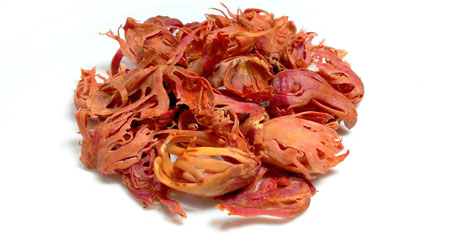What Is Mace?
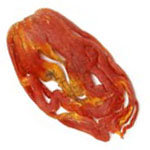
Mace as well as the nutmeg seeds were thought to have originated in the tropical rain forest of Indonesian Maluku Islands, also known as the spice Islands. Mace spice is a dried, outer aril, enveloping firmly around the nutmeg kernel. Nutmeg kernel and mace arils indeed are two separate spice products of same nutmeg fruit. However, mace characteristically composes higher concentration of certain essential oils and features refined yet intense aroma than nutmeg.
Mace Plant and Cultivation
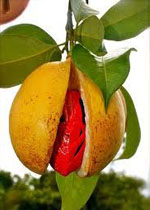
Mace tree is a perennial ever green spice tree and a native of Molluccas in East Indonesia. Mace crop grows well in humid and warm climatic conditions. This crop requires an annual rainfall of 150 cm above. These trees grow up to 1000 meters above msl (mean sea level). The best suited soils for Mace cultivation are sandy loam, clay loam and red laterite. Draught and water stagnation conditions are not suitable for Mace farming. Mace tree grows best with a pH level of 6.0 to 7.0. Propagation is mainly done by seeds. As mace trees are perennial and dioeciously in nature, an alternative method of propagation is in progress. Epicotyls grafting, patch budding and approach grafting are most successful in mace tree propagation.
Generally a female mace tree starts fruiting from the 6th year and the peak harvesting period reaches after 20 years. The nutmeg fruits will be ready for harvesting 9 months after flowering. In mace farming, flowering and harvesting continues throughout the year. The mace fruits ripen and become ready for harvesting when their pericarp splits open. Harvesting should be done by bill hook. The outer fleshy portion should be removed and the mace should manually be separated from the nut. The nuts and mace should be dried separately for 3 to 5 days.
Mace Description
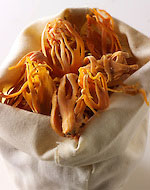
Myristica fragrans tree yields nutmeg fruits up to three times in a season. Once harvested from the tree, its outer pulp or husk is removed and discarded. Just underneath the tough husk is the golden-brown color aril, known as "mace," enveloping firmly around the nutmeg kernel. Mace is gently peeled off from the kernel surface, flattened into strips, dried, and sold either as whole "mace blades" or finely ground into powder. The nutmeg kernels are then dried under sun for several days to weeks. At larger commercial set-ups, this process is carried out rather more quickly over a hot drier machine until the whole nutmeg rattles inside the shell.
Uses of Mace
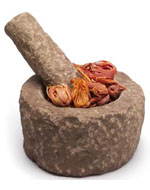
Mace powder has a distinct spicy-sweet taste and is used to flavor food, domestically and commercially. It is a commonly used ingredient in desserts and baked products like pies, milk custards, puddings, fruit dishes, biscuits, muffins, cakes and breads. The essential oils and nutrients present in mace powder are responsible for its medicinal value. Traditionally, it is known to be anti-fungal, anti-depressant, aphrodisiac, digestive and carminative agent. It is a good source of minerals like copper, potassium, calcium, manganese, iron, zinc and magnesium. It also is rich in B vitamins, Vitamin C, vitamin A and many flavonoid antioxidants like beta carotene and cryptoxanthins.
10 Health Benefits of Mace
1 - Helps treat insomnia - Mace is known for a high content of magnesium, that decreases nerve tension, and also energizes the release of serotonin, making a sense of relaxation or even sedation.
2 - Improve brain health - Mace consists of important oils just like myristicin and macelignan which have been shown to decrease the degradation of neural pathways as well as cognitive function which generally affects people with possibly dementia or Alzheimer’s disease.
3 - Dental Health - Mace spice makes certain excellent dental health too. With this particular, you are able to eliminate foul breath successfully and safeguard the teeth from all of dental issues. The spice is really a natural treatment for tooth pains as well as aching gums and is also utilized in a number of toothpastes as well.
4 - Nervous System - In some traditional medications (Chinese and Indian), mace has been utilized to deal with nervous system illnesses. It is stated to have a calming effect on the brain, whilst supplying some kind of stimulation. It does this since it consists of myristicin as well as elemicin.
5 - Help individuals with indigestion - The fiber content in mace can stimulate the digestive process, increase the secretion of gastric and intestinal juices, and reduce the frequency and discomfort of constipation.
6 - Helps treat inflammation - Mace oil has great abilities of treating muscular and joint pains and sores as it is an excellent sedative. It also has anti-inflammatory properties and can be very useful for treating arthritis and rheumatism.
7 - Prevent Cancer - Mace may help to treat and prevent cancer by inhibiting the formation of blood vessels that feeds cancer tumors.
8 - Improves Cardiovascular Health - Mace spice contains good amounts of potassium, which helps maintain the heart functions. It acts as a vasodilator and helps the blood vessel to relax. It is a good cure for hypertension and improves blood circulation. It helps maintain normal heart rate and blood pressure.
9 - Excellent For Skin Care - Mace spice is an integral part of traditional skin care. Its antibacterial, anti-inflammatory and soothing properties have made it find an important place in the skin care regime. It reduces irritation and hydrates the skin. It helps fade out acne marks and removes blackheads. It clears spores and exfoliates dead skin. Thus, it leaves the skin healthy and radiant.
10 - Bad Breath Treatment - Bad breath is caused due to bacteria build-up in the mouth. Mace helps in getting rid of bacteria in the mouth. Hence, it is one of the common ingredients in several toothpaste brands. Also, it treats toothache and other gum problems.
Producing Countries of Mace
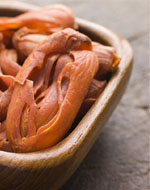
Indonesia and Grenada are the world's largest producers of high quality Nutmeg and Mace. Indonesia has close to 75% of the world market share with Granada having nearly 20% of the market share. The remaining 5% production is done by other countries including India, Malaysia, Sri Lanka, Papua New Guinea and other Caribbean islands such as St. Vincent.The nutmeg tree is native to a region known as the Spice Islands near tropical Indonesia and parts of Southeast Asia. Nutmeg trees are also found in Kerala, the southernmost state of India. The Dutch introduced Mace to Europeans, who at one time held an alarming spice monopoly in most of Southeast Asia.
Consuming Countries of Mace

The principal import markets of mace are the European Community, the United States, Japan and India. Singapore and Netherlands are one of the largest exporting countries of the spice.
Recipe for Beverages with Mace
St. Lucian Chocolate Tea
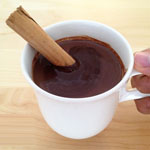
Ingredients: A: 4 ounces unsweetened cocoa power B: 1/2 tablespoon lime zest C: 1/4 teaspoon cinnamon D: 1/8 teaspoon nutmeg E: Pinch of mace F: Pinch of cayenne powder G: 2 cups milk (add more if you prefer a thinner consistency) H: 1 whole bay leaf I: 1 whole star anise J: 1 whole vanilla bean or 1/4 tsp. vanilla extract K: 3/4 cup sugar
Preparation MethodA: In a small mixing bowl combine the chocolate, zest, cinnamon, nutmeg, mace, and cayenne. B: In a small saucepan warm the milk. Stir to avoid scalding. C: Add the bay leaf, star anise, vanilla bean, and sugar. Bring to a simmer and whisk in the chocolate mixture. Whisk well as it cooks to prevent lumping. Simmer the mixture for eight to ten minutes until slightly thickened and rich.
Recipe for Cooking with Mace
Potted Shrimp with Mace Butter
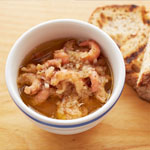
Ingredients: A: 3 shallots, finely diced B: 2 garlic cloves, minced C: 1 tsp ground mace D: 1/4 tsp cayenne pepper E: 1/2 tsp paprika F: 1 tbsp of rapeseed oil G: 250g of clarified butter H: 250g of brown shrimp, cooked and peeled I: flaky sea salt J: 4 slices of sourdough bread, toasted
Preparation MethodA: Heat the oil in a saucepan over a medium heat. Sauté the shallots and garlic for 1 minute, then add the spices and cook for a further 3 minutes. B: Add the butter and season well with salt. Remove the pan from the heat and stir in the brown shrimp – they should be just warm. C: Divide the shrimp between 4 ramekins and serve with toasted sourdough bread.
Recipe for Dessert with Mace
Pear Gingerbread Tart in Mace & Salted Caramel

Ingredients: A: 1 pear B: 3 tablespoons of ready-made salted caramel sauce C: 1/2 Pack of ready-made Gingerbread dough D: 2-3 petals of mace E: butter for tin greasing
Preparation MethodA: Preheat your oven to 180c and grease a tart tin. B: Place the salted caramel and mace in a small heat-proof bowl and set it in a pan of hot water to simmer gently until the caramel is melted and is fully liquid. Infuse the mace for 20 mins. C: Roll out the gingerbread dough and place in the tart tin with edges overhanging. Push the dough carefully into the corners of the tin, then cut the edges off with a sharp knife and prick the base all over with a fork. D: Bake the gingerbread for 5-10 mins until golden. Remove from the oven and leave to cool. E: Wash, dry and thinly slice one pear. Layer the tart base with the pear and drizzle the caramel sauce all over. F: Place back in the oven and bake for another 10 mins. Leave to cool before serving.

